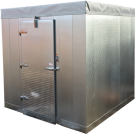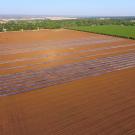Innovation in this area is teeming currently, especially at UC Davis. The FDA’s food recovery hierarchy stipulates that excess food should first go to feeding hungry people, and if this solution is not available, then using the waste for industry and composting should redirect the food from the landfill. Researchers at UC Davis are developing exciting solutions throughout this chain, from recovering high value nutritional compounds from whey in cheese making to advancing microbial fuel cells that can transform organic wastes into renewable energy. The current levels of food waste throughout the system demand solutions at every level of the system--this work is vital in adding real value to what has previously been considered waste.
Circular Solutions for Food Recovery and Recycling
Projects
Publications
Sá, A.G.A., Pacheco, M.T.B., Moreno, Y.M.F. and Carciofi, B.A.M., 2023. Processing effects on the protein quality and functional properties of cold-pressed pumpkin seed meal. Food Research International, 169, 112876. [doi:10.1016/j.foodres.2023.112876]
Sá, A.G.A., Pacheco, M.T.B., Moreno, Y.M.F. and Carciofi, B.A.M., 2022. Cold-pressed sesame seed meal as a protein source: Effect of processing on the protein digestibility, amino acid profile, and functional properties. Journal of Food Composition and Analysis, 111, 104634.
Sá, A.G.A., Laurindo, J.B., Moreno, Y.M.F. and Carciofi, B.A.M., 2022. Influence of emerging technologies on the utilization of plant proteins. Frontiers in Nutrition, 9, 809058. [doi: 10.3389/fnut.2022.809058]
Kumar, M., Chandran, D., Tomar, M., Bhuyan, D.J., Grasso, S., Sá, A.G.A., Carciofi, B.A.M., Radha, Dhumal, S., Singh, S. and Senapathy, M., 2022.
Sinrod, A. J. G., X. Li, M. Bhattacharya, B. Paviani, S. C. Wang, D. Barile. A second life for wine grapes: Discovering potentially bioactive oligosaccharides and phenolics in chardonnay marc and its processing fractions. LWT - Food Science and Technology. Volume 144. 2021. https://doi.org/10.1016/j.lwt.2021.111192
Risner, D., M. L. Marco, S. A. Pace, E. S. Spang. The Potential Production of the Bioactive Compound Pinene Using Whey Permeate. Processes 2020, 8(3), 263. https://doi.org/10.3390/pr8030263
Fernandez-Bayo, J. D., Shea, E. A., Parr, A. E., Achmon, Y., Stapleton, J. J., VanderGheynst, J. S., ... & Simmons, C. W. (2020). Almond processing residues as a source of organic acid biopesticides during biosolarization. Waste Management, 101, 74-82.
Vidyarthi, S. K., & Simmons, C. W. (2020). Characterization and management strategies for process discharge streams in California industrial tomato processing. Science of the Total Environment, 723, 137976.
de Moura Bell, J. M. L. N., J. L. Cohen, L. F.M.C. de Aquino, H. Lee, V. L. de Melo Silva, Y. Liu, P. Domizio, D. Barile. (2018). An integrated bioprocess to recover bovine milk oligosaccharides from colostrum whey permeate. Journal of Food Engineering 216: 27-35. https://doi.org/10.1016/j.jfoodeng.2017.07.022
Cohen, J.L., D. Barilea, Y. Liu, J. M. L. N. de Moura Bell. (2017). Role of pH in the recovery of bovine milk oligosaccharides from colostrum whey permeate by nanofiltration. International Dairy Journal 66: 68-75. https://doi.org/10.1016/j.idairyj.2016.10.016
de Moura Bell, J. M. L. N., L. F. M. C. Aquino, Y. Liu, J. L. Cohen, H. Lee, V. L. de Melo Silva, M. I. Rodrigues, D. Barile. Modeling lactose hydrolysis for efficiency and selectivity: Toward the preservation of sialyloligosaccharides in bovine colostrum whey permeate. (2016). Journal of Dairy Science 99(8): 6157-6163. https://doi.org/10.3168/jds.2016-11065
de Moura Bell, J.M.L.N., J. L. Cohen, M. Geissler, D. Barile, C.W. Simmons. (2015). Agricultural Wastes: Characteristics, Types and Management. 978-1-63482-376-0. Current Utilization of Dairy Industry Co-products. Camille N. Foster (editor in chief).
Mehra, R., D. Barile , M. Marotta, C. B. Lebrilla, C. Chu, J. B. German. (2014). Novel High-Molecular Weight Fucosylated Milk Oligosaccharides Identified in Dairy Streams. PLoS ONE 9(5): e96040. https://doi.org/10.1371/journal.pone.0096040
Lee, H., B. German, R. Kjelden, C. B. Lebrilla, D. Barile. (2013). Quantitative Analysis of Gangliosides in Bovine Milk and Colostrum-Based Dairy Products by Ultrahigh Performance Liquid Chromatography-Tandem Mass Spectrometry. Journal of Agricultural and Food Chemistry 2013 61 (40), 9689-9696 DOI: 10.1021/jf402255g
Hill, G., Sayadi, A., Gendreau, J., Tobar, Z., Liu, Y., Pitesky, M., & Simmons, C. Assessment of the variation in nutritional composition and safety of dried recovered food from US households and prospects for use in chicken feed. Frontiers in Sustainable Food Systems, 7, 1180249.






